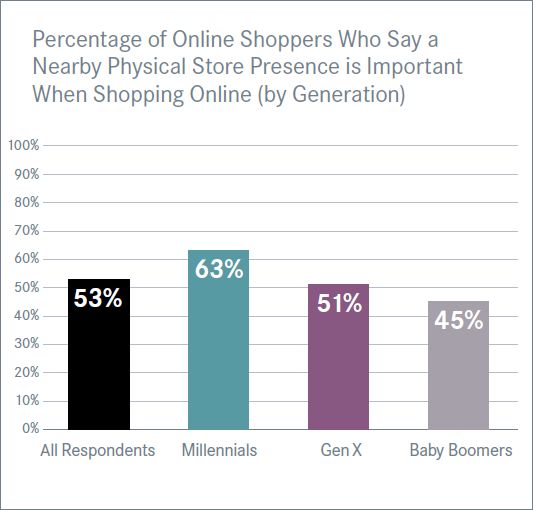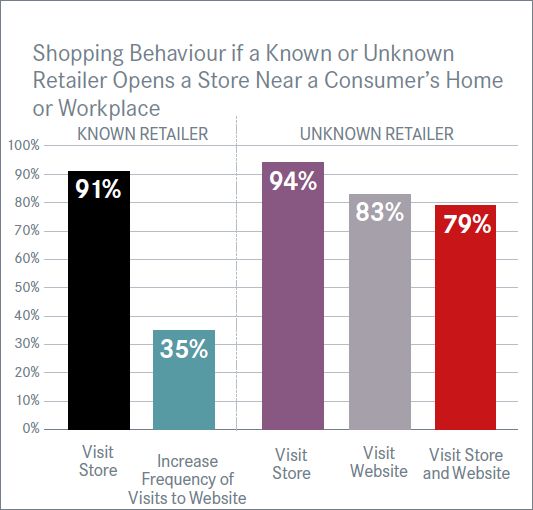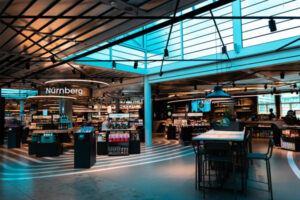
A new survey of 7,000 European consumers by the International Council of Shopping Centers (ICSC) supports the symbiotic relationship between the physical and digital worlds and dispels the notion that online channels are eroding the value of brick-and-mortar stores to consumers.
ICSC found that over half of online shoppers say it is important for retailers to have a physical store presence as well, reinforcing the belief that today’s consumers are very much in charge of their journey and demand to shop in any combination of channels, utilising the easiest, shortest and most pleasurable path to accomplish their mission.
Tellingly, despite being regarded as the more digitally-connected generation, it is the Millennials, rather than their older counterparts, who see the greatest value in a physical presence when making online purchases. Almost two-thirds of Millennial online shoppers said that a local store is very important or somewhat important, compared with half of Gen X consumers and 45% of Baby Boomers. Given that Millennials are now entering their peak spending years, this bodes well for the continued success of bricks-and-mortar retailing.
The survey revealed that the primary motivations for shopping online from an omnichannel retailer are exclusive offerings, a wider selection of products that are available online, and the ability to collect, return or exchange items in-store, thereby avoiding shipping fees. This insight underpins the importance of the store in the overall shopping journey, playing a key fulfilment and service role even if the transaction ultimately closes online.
RETAILERS LOSE CUSTOM WHEN THEY CLOSE A STORE
Indeed, the value that consumers place on being able to access a local store is so high that there are notable changes in shopping behaviour when a retailer closes a physical establishment.
Although the majority of consumers display brand loyalty by saying they would continue to buy from a retailer if it closed a nearby store (either moving online or to a different physical location), a noteworthy two-fifths of European consumers would no longer spend their money with that retailer – 18% would switch to buying in-store from another retailer, 14% would switch to buying online from another retailer and 7% wouldn’t spend the money anywhere else. This represents a significant loss of the retailer’s existing custom in that catchment area, with the large majority of which going to a competing brand–something that retailers should consider carefully when making decisions about portfolio rationalisation.
The survey revealed that the presence of physical stores is a key driver of brand perception. A third of European consumers said that if a retailer closed a local store, one of the main reasons why they would no longer buy from that company is their concern that the retailer is not doing well and could go out of business.
Stores also play a significant role in brand awareness as 28% of consumers who would no longer buy from a retailer that closes a store near them said that if they do not see the physical store, the retailer is no longer top of mind. A further key reason for the loss of custom when a retailer closes a local store is that consumers are no longer able to return/exchange items easily or receive customer service.
OPENING A STORE BOOSTS ONLINE TRAFFIC
The direct relationship between the online and physical channels is so marked that when a retailer opens a new store there is a positive impact on consumers’ digital engagement. Approximately nine out of 10 (91%) consumers said that they would visit the new store but, importantly and in support of retailers’ omnichannel strategies, 35% of consumers would increase the frequency of visits to the retailer’s website as a direct result of a nearby store opening, regardless of whether or not they also visit the new establishment.
This trend is even more pronounced for unfamiliar retailers that may also include new and emerging retailers. An overwhelming 94% of consumers said they would visit a new local store of a previously unknown retailer and 83% would visit the retailer’s website as a direct result of the presence of the new physical establishment that is of interest to them.
What is clear is that for today’s channel-agnostic consumers, bricks and clicks is not an either/or decision. They move back and forth between the two throughout the shopping journey and expect the same experience across all channels. Approximately four-fifths (79%) of those surveyed said they would visit both the store and the website if an unfamiliar retailer opens a new store near their home or work–the majority of which would go to the store first. This supports the view that the physical and digital cannot function in silo–they invariably need to seamlessly co-exist and complement one another in order to preserve and enhance consumer engagement.
As Sarah Cole, Manager of International Research at ICSC based in London, highlights: “The survey results confirm what we have long suspected–stores continue to play a vital role in consumers’ shopping journeys and are an integral part of a retailer’s ecosystem, regardless of where the final transaction takes place. Positioning bricks against clicks paints a misleading picture and undervalues the role of the store in consumer engagement and building connections, particularly for unfamiliar retailers. The presence of physical stores builds trust and confidence in a brand and provides a crucial opportunity for consumers to access before and after-sale support, as well as fostering click-and-collect.”
In short, physical stores are essential to any successful retail strategy. Not only do they drive online engagement, but they also positively impact brand perception and help to attract new customers. Those retailers that innovate and create a true omnichannel experience by leveraging the strengths of both physical and digital will meet the needs of today’s informed and empowered consumers and will ultimately come out on top.
KEY STATS
• More than half of online shoppers say that when buying online it is important for that retailer to have a physical store presence near their home or work.
• Nearly two-thirds (63%) of Millennial online shoppers say that the presence of a local store is very important or somewhat important, compared with 51% for Gen X and 45% for Baby Boomers.
• If a retailer they currently patronise closes a local store, two-fifths of European consumers would no longer spend their money with that retailer.
• More than one-third (35%) of consumers would increase the frequency of visits to a known retailer’s website as a direct result of a new store opening near their home or work.
• More than four-fifths (83%) of consumers would visit an unfamiliar retailer’s website as a direct result of a nearby store opening.
• If an unfamiliar retailer opened a nearby store, 79% of consumers would visit both the store and the website, with the majority of these consumers going to the store first.
ABOUT THE SURVEY
These findings are based on a survey of over 7,000 adults in seven European countries (France, Germany, Italy, the Netherlands, Poland, Spain and the UK), conducted between January 11 and 16, 2019 by Engine Group on behalf of ICSC.








